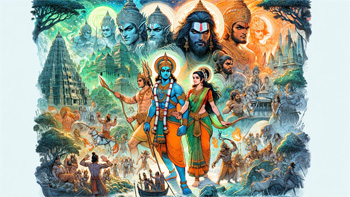The Ramayana, one of the great Indian epics, is a captivating tale of adventure, love, bravery, and morality. Composed by the sage Valmiki, this ancient narrative not only tells the story of Prince Rama but also imparts crucial lessons on duty and righteousness. Spanning across seven books and comprising thousands of verses, the Ramayana has been a cornerstone of Indian culture and spirituality for centuries, influencing art, literature, and daily life.
This epic's narrative weaves through the life of Rama, the prince of Ayodhya, and his unwavering adherence to dharma (moral and righteous duty) despite harsh trials. The Ramayana is more than a story; it's a medium through which profound life lessons are imparted, resonating deeply with people across ages and geographies.
The Core Story of the Ramayana
The Ramayana's story begins with Rama, the eldest son of King Dasharatha of Ayodhya, being exiled to the forest for 14 years due to a promise his father made to one of his wives. Rama's devoted wife, Sita, and his loyal brother, Lakshmana, accompany him. In the forest, Sita is abducted by Ravana, the demon king of Lanka, setting the stage for the epic's central conflict.
Rama, assisted by his devotee Hanuman and an army of monkeys, sets out to rescue Sita. The narrative culminates in the legendary battle in Lanka, where Rama defeats Ravana and rescues Sita. The epic concludes with Rama's return to Ayodhya, his coronation as king, and the establishment of Ramarajya, a period of perfect justice and righteousness.
Characters and Symbolism in the Ramayana
The characters in the Ramayana are symbolic of various virtues and vices. Rama, the protagonist, is often considered the embodiment of dharma, virtue, and ideal leadership. Sita represents loyalty and purity, while Lakshmana symbolizes brotherly devotion and sacrifice. Hanuman, a central figure in the latter part of the epic, is revered for his unwavering dedication to Rama.
Ravana, the antagonist, though a learned scholar and a powerful ruler, symbolizes ego and unrighteousness. The interactions and conflicts between these characters are not just literal narratives but also represent the eternal battle between good and evil, righteousness and immorality.
Moral and Ethical Lessons in the Ramayana
The Ramayana is a rich source of moral and ethical teachings. It emphasizes the importance of fulfilling one's duties, respecting elders, and remaining true to one's principles, even in the face of adversity. The epic teaches the value of relationships, whether it's the bond between husband and wife, brother and brother, or a devotee and his lord.
Through its characters and their journeys, the Ramayana showcases the significance of righteousness and the consequences of deviating from the path of dharma. These lessons have made the Ramayana a guide for righteous living in various cultures, particularly in the Indian subcontinent.
The Ramayana's Influence on Culture and Art
The Ramayana has had a profound impact on the art and culture of India and other Asian countries. It has inspired a myriad of art forms, including literature, dance, drama, and painting. The story has been told and retold in countless languages and formats, adapting to the tastes and sensibilities of various cultures and eras.
From traditional Ramleela performances, which enact scenes from the Ramayana, to modern film adaptations, the epic continues to be a vital part of cultural expression. The themes and characters of the Ramayana resonate deeply in the collective consciousness, influencing personal values and societal norms.
The Ramayana's Relevance in the Modern World
In today's world, the Ramayana's teachings continue to be relevant. The epic's emphasis on dharma, or righteous duty, resonates in a world seeking moral and ethical direction. The characters' trials and triumphs provide insights into handling life's challenges with grace and integrity.
The Ramayana is not just a religious or mythological story; it is a guide to living a balanced and moral life. Its emphasis on virtues like loyalty, courage, and devotion makes it a timeless tale, offering wisdom that is as pertinent today as it was thousands of years ago.
In the vast expanse of Hindu mythology, the Ramayana holds a place of particular reverence, intertwining the historical and the spiritual aspects of Hinduism. This epic is not just a pillar of Hindu literature but also a foundational aspect of Hindu culture and religion. It offers a window into the ancient world of Hindu gods and goddesses, heroes and demons, and their interplay with human values and ethics. The teachings of the Ramayana go beyond religious doctrines, providing insights into the human condition through the lens of Hindu philosophy. The narrative, rich in allegory and symbolism, resonates with core Hindu beliefs and practices, making it a timeless epic that continues to shape the moral and cultural ethos of Hindu society.
As a piece of literature, the Ramayana is an epic adventure, a story of love, separation, and reunion. As a moral guide, it is a beacon of righteousness. In every aspect, the Ramayana remains a profound narrative, deeply embedded in the cultural fabric of societies, guiding, inspiring, and teaching generations across time and space.
